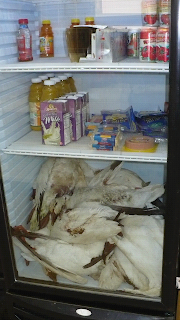It would have been great if things had gone as planned – if Little Guy was floating in his slip I would have been able to work on the trailer in my driveway and then put it in storage at a buddy’s farm. Instead, I had to work on the trailer with the boat on it. I borrowed my brother’s floor jack, in conjunction with mine, and used them to jack the boat up, providing clearance to get the wheel on the metal cog. I had to use some wood to raise the jacks up so they would be able, in turn, to raise the boat properly. Unfortunately the position of the wheel near the middle of the boat meant that I had to jack the boat very high and pivot it against the bow support. Even with the wood and the jacks at maximum extension I was unable to get the three or four inches of clearance required to mount the new wheel on the support.
Time to go with a plan B. I considered going to Home Depot and buying a smaller diameter wheel that would be able to serve as a temporary replacement for the proper wheel. But really what I needed was something that could serve as a padded support for transport to avoid further damage to the hull, and not be an obstacle for the eventual launch. I searched the garage to find something that could meet this requirement.
I don’t have an inventory of wheels, but I do have a pile of lacrosse balls in a box of sporting goods. I pulled out my drill and trusty collection of drill bits and drilled a half inch hole in a lacrosse ball and wedged it over the square steel support rail.
.GIF)
.GIF)
.GIF)
.GIF)

Project Expense: $0.00
Say’s Law formulation by John Maynard Keynes: “Supply creates its own demand”
Remaining lacrosse ball inventory: 18
Greg Rynne’s number at TJHSST Lacrosse: 18
Woodbridge lax carpool numbers: Rynne – 18 (voter), Lance – 21 (drinker), Mack – 16 (driver)
Other balls in the box: field hockey, racquet, tennis, soft, foot (nerf and leather)














